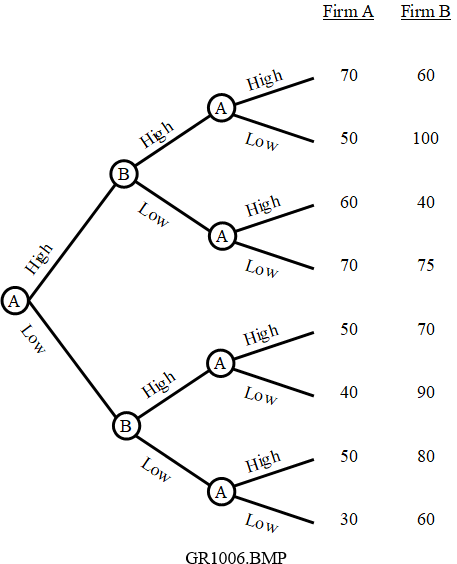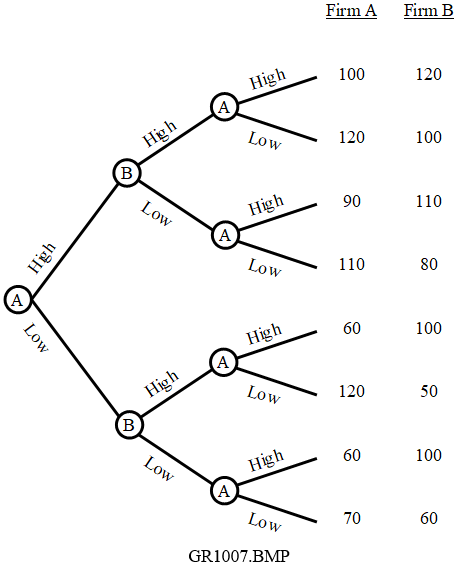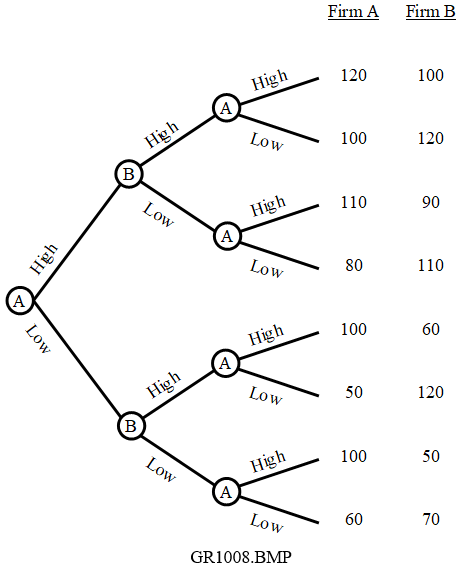Deck 9: Game Theory and Strategic Behavior
سؤال
سؤال
سؤال
سؤال
سؤال
سؤال
سؤال
سؤال
سؤال
سؤال
سؤال
سؤال
سؤال
سؤال
سؤال
سؤال
سؤال
سؤال
سؤال
سؤال
سؤال
سؤال
سؤال

فتح الحزمة
قم بالتسجيل لفتح البطاقات في هذه المجموعة!
Unlock Deck
Unlock Deck
1/23
العب
ملء الشاشة (f)
Deck 9: Game Theory and Strategic Behavior
1
Game theory can be used to analyze nonprice competition in oligopolistic markets.
True
2
Game theory is particularly useful in analyzing multiple-move decision-making situations.
False
3
One criticism of game theory is that, by considering only the best outcome of each strategy, it views the world in an excessively optimistic light.
False
4
Game theory is concerned with identifying optimal strategies in conflict situations.

فتح الحزمة
افتح القفل للوصول البطاقات البالغ عددها 23 في هذه المجموعة.
فتح الحزمة
k this deck
5
The prisoners' dilemma refers to a situation in which both players cooperate in determining a strategy.

فتح الحزمة
افتح القفل للوصول البطاقات البالغ عددها 23 في هذه المجموعة.
فتح الحزمة
k this deck
6
A tit-for-tat strategy cannot be successfully employed in repeated games.

فتح الحزمة
افتح القفل للوصول البطاقات البالغ عددها 23 في هذه المجموعة.
فتح الحزمة
k this deck
7
The prisoner's dilemma provides an explanation for price wars among oligopolists.

فتح الحزمة
افتح القفل للوصول البطاقات البالغ عددها 23 في هذه المجموعة.
فتح الحزمة
k this deck
8
The prisoner's dilemma is unable to explain the seeming inability of most commodity cartels to maintain high prices.

فتح الحزمة
افتح القفل للوصول البطاقات البالغ عددها 23 في هذه المجموعة.
فتح الحزمة
k this deck
9
Firms in a cartel "cheat" by selling more output than they are supposed to.

فتح الحزمة
افتح القفل للوصول البطاقات البالغ عددها 23 في هذه المجموعة.
فتح الحزمة
k this deck
10
A credible threat is one that is not believable.

فتح الحزمة
افتح القفل للوصول البطاقات البالغ عددها 23 في هذه المجموعة.
فتح الحزمة
k this deck
11
Tit-for-tat is a strategy that cannot be applied in repeated games.

فتح الحزمة
افتح القفل للوصول البطاقات البالغ عددها 23 في هذه المجموعة.
فتح الحزمة
k this deck
12
Decision trees represent strategies and outcomes in the form of a branching diagram.

فتح الحزمة
افتح القفل للوصول البطاقات البالغ عددها 23 في هذه المجموعة.
فتح الحزمة
k this deck
13
The technique of backward induction involves starting at the beginning of a decision tree and working through to the end.

فتح الحزمة
افتح القفل للوصول البطاقات البالغ عددها 23 في هذه المجموعة.
فتح الحزمة
k this deck
14
The strategy of being the first to enter a new market may result in a "first mover" advantage.

فتح الحزمة
افتح القفل للوصول البطاقات البالغ عددها 23 في هذه المجموعة.
فتح الحزمة
k this deck
15
Government industrial policies and strategies can be described using game theory.

فتح الحزمة
افتح القفل للوصول البطاقات البالغ عددها 23 في هذه المجموعة.
فتح الحزمة
k this deck
16
A market has only two sellers. They are both trying to decide on a pricing strategy. If both firms charge a high price, then each firm will experience a 10% increase in profits. If both firms charge a low price, then each firm will experience a 5% decrease in profits. If Firm 1 charges a low price and Firm 2 charges a high price, then Firm 1 will experience a 6% increase in profits and Firm 2 will experience a 2% decrease in profits. If Firm 2 charges a low price and Firm 1 charges a high price, then Firm 2 will experience a 7% increase in profits and Firm 1 will experience a 3% decrease in profits.
(I) Construct a payoff matrix for this game.
(ii) Determine whether each firm has a dominant strategy and, if it does, identify the strategy.
(iii) Determine the optimal strategy for each firm.
(iv) Determine the Nash equilibrium.
(v) Is this a prisoners' dilemma? How do you know?
(I) Construct a payoff matrix for this game.
(ii) Determine whether each firm has a dominant strategy and, if it does, identify the strategy.
(iii) Determine the optimal strategy for each firm.
(iv) Determine the Nash equilibrium.
(v) Is this a prisoners' dilemma? How do you know?

فتح الحزمة
افتح القفل للوصول البطاقات البالغ عددها 23 في هذه المجموعة.
فتح الحزمة
k this deck
17
A market has only two sellers. They are both trying to decide on a pricing strategy. If both firms charge a high price, then each firm will experience a 5% decrease in profits. If both firms charge a low price, then each firm will experience a 2% increase in profits. If Firm 1 charges a high price and Firm 2 charges a low price, then Firm 1 will experience a 1% increase in profits and Firm 2 will experience a 4% increase in profits. If Firm 2 charges a high price and Firm 1 charges a low price, then Firm 2 will experience a 3% increase in profits and Firm 1 will experience a 4% increase in profits.
(i) Construct a payoff matrix for this game.
(ii) Determine whether each firm has a dominant strategy and, if it does, identify the strategy.
(iii) Determine the optimal strategy for each firm.
(iv) Determine the Nash equilibrium.
(v) Is this a prisoners' dilemma? How do you know?
(i) Construct a payoff matrix for this game.
(ii) Determine whether each firm has a dominant strategy and, if it does, identify the strategy.
(iii) Determine the optimal strategy for each firm.
(iv) Determine the Nash equilibrium.
(v) Is this a prisoners' dilemma? How do you know?

فتح الحزمة
افتح القفل للوصول البطاقات البالغ عددها 23 في هذه المجموعة.
فتح الحزمة
k this deck
18
A market has only two sellers. They are both trying to decide on a pricing strategy. If both firms charge a high price, then each firm will experience a 5% increase in profits. If both firms charge a low price, then each firm will experience a 3% increase in profits. If Firm 1 charges a high price and Firm 2 charges a low price, then Firm 1 will experience a 1% increase in profits and Firm 2 will experience a 6% increase in profits. If Firm 2 charges a high price and Firm 1 charges a low price, then Firm 2 will experience a 2% increase in profits and Firm 1 will experience a 7% increase in profits.
(i) Construct a payoff matrix for this game.
(ii) Determine whether each firm has a dominant strategy and, if it does, identify the strategy.
(iii) Determine the optimal strategy for each firm.
(iv) Determine the Nash equilibrium.
(v) Is this a prisoners' dilemma? How do you know?
(i) Construct a payoff matrix for this game.
(ii) Determine whether each firm has a dominant strategy and, if it does, identify the strategy.
(iii) Determine the optimal strategy for each firm.
(iv) Determine the Nash equilibrium.
(v) Is this a prisoners' dilemma? How do you know?

فتح الحزمة
افتح القفل للوصول البطاقات البالغ عددها 23 في هذه المجموعة.
فتح الحزمة
k this deck
19
A market has only two sellers. They are both trying to decide on a pricing strategy. If both firms charge a high price, then each firm will experience a 5% increase in profits. If both firms charge a low price, then each firm will experience a 3% decrease in profits. If Firm 1 charges a high price and Firm 2 charges a low price, then Firm 1 will experience a 4% decrease in profits and Firm 2 will experience a 6% increase in profits. If Firm 2 charges a high price and Firm 1 charges a low price, then Firm 2 will experience a 5% decrease in profits and Firm 1 will experience a 7% increase in profits.
(i) Construct a payoff matrix for this game.
(ii) Determine whether each firm has a dominant strategy and, if it does, identify the strategy.
(iii) Determine the optimal strategy for each firm.
(iv) Determine the Nash equilibrium.
(v) Is this a prisoners' dilemma? How do you know?
(i) Construct a payoff matrix for this game.
(ii) Determine whether each firm has a dominant strategy and, if it does, identify the strategy.
(iii) Determine the optimal strategy for each firm.
(iv) Determine the Nash equilibrium.
(v) Is this a prisoners' dilemma? How do you know?

فتح الحزمة
افتح القفل للوصول البطاقات البالغ عددها 23 في هذه المجموعة.
فتح الحزمة
k this deck
20
A pair of duopolists, Firm A and Firm B, manufacture seasonal toys. Both are planning their pricing strategies for the coming holiday season. The firms will choose between a low price (Low) and a high price (High). Firm A has a more flexible production and distribution system than Firm B and is therefore able to begin the season with one pricing strategy and then adopt a different strategy in mid-season. While Firm B is unable to change its strategy in mid-season, it can delay making a choice until after Firm A has announced its prices for the first part of the season. The firms' alternatives and payoffs are displayed in the decision tree diagram. Use this information to determine each firm's optimal strategy and anticipated payoff.



فتح الحزمة
افتح القفل للوصول البطاقات البالغ عددها 23 في هذه المجموعة.
فتح الحزمة
k this deck
21
A pair of duopolists, Firm A and Firm B, manufacture seasonal toys. Both are planning their pricing strategies for the coming holiday season. The firms will choose between a low price (Low) and a high price (High). Firm A has a more flexible production and distribution system than Firm B and is therefore able to begin the season with one pricing strategy and then adopt a different strategy in mid-season. While Firm B is unable to change its strategy in mid-season, it can delay making a choice until after Firm A has announced its prices for the first part of the season. The firms' alternatives and payoffs are displayed in the decision tree diagram. Use this information to determine each firm's optimal strategy and anticipated payoff.



فتح الحزمة
افتح القفل للوصول البطاقات البالغ عددها 23 في هذه المجموعة.
فتح الحزمة
k this deck
22
A pair of duopolists, Firm A and Firm B, manufacture seasonal toys. Both are planning their pricing strategies for the coming holiday season. The firms will choose between a low price (Low) and a high price (High). Firm A has a more flexible production and distribution system than Firm B and is therefore able to begin the season with one pricing strategy and then adopt a different strategy in mid-season. While Firm B is unable to change its strategy in mid-season, it can delay making a choice until after Firm A has announced its prices for the first part of the season. The firms' alternatives and payoffs are displayed in the decision tree diagram. Use this information to determine each firm's optimal strategy and anticipated payoff.



فتح الحزمة
افتح القفل للوصول البطاقات البالغ عددها 23 في هذه المجموعة.
فتح الحزمة
k this deck
23
A pair of duopolists, Firm A and Firm B, manufacture seasonal toys. Both are planning their pricing strategies for the coming holiday season. The firms will choose between a low price (Low) and a high price (High). Firm A has a more flexible production and distribution system than Firm B and is therefore able to begin the season with one pricing strategy and then adopt a different strategy in mid-season. While Firm B is unable to change its strategy in mid-season, it can delay making a choice until after Firm A has announced its prices for the first part of the season. The firms' alternatives and payoffs are displayed in the decision tree diagram. Use this information to determine each firm's optimal strategy and anticipated payoff



فتح الحزمة
افتح القفل للوصول البطاقات البالغ عددها 23 في هذه المجموعة.
فتح الحزمة
k this deck








